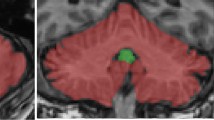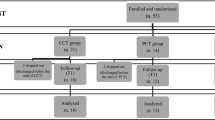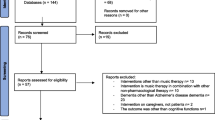Abstract
While deep brain stimulation (DBS) surgery is a well-accepted treatment for Parkinson disease (PD) that improves overall quality of life (QoL), its effects across different domains of QoL are unclear. The study reported here directly compared the effects of unilateral DBS in subthalamic nucleus (STN) or globus pallidus (GPi) on QoL in 42 non-demented patients with medication-refractory PD. Patients were enrolled in the COMPARE trial, a randomized clinical trial of cognitive and mood effects of STN versus GPi DBS conducted at the University of Florida Movement Disorders Center. Patients underwent motor, mood, verbal fluency and QoL (Parkinson disease questionnaire: PDQ-39) measures before and 6 months following surgery. Groups experienced motor and mood improvements that did not differ by target. Patients with STN DBS evidenced a slight decrement on letter fluency. On average, all patients endorsed better overall QoL after surgery. However, despite similar motor and mood improvements, GPi patients improved more than STN patients (38 vs. 14%, respectively; P = 0.03). Patients reported better QoL on subscales of mobility, activities of daily living (ADLs), emotional well-being, stigma, cognition and discomfort, but not on those of social support and communication. Improvements on the mobility, ADLs, stigma and social support subscales were greater amongst GPi patients. In regression analyses, only depression changes independently predicted changes in overall QoL as well as emotional well-being and social support changes. Within the STN group only, declining category fluency scores correlated with poorer QoL on the communication subscale. Unilateral DBS in both STN and GPi improved QoL overall and in disparate domains 6 months after surgery. Patients receiving GPi DBS reported greater improvements that cannot be explained by differential mood or motor effects; however, verbal fluency changes may have partially contributed to lesser QoL improvements amongst STN patients.

Similar content being viewed by others
References
Alberts JL, Hass CJ, Vitek JL, Okun MS (2008) Are two leads always better than one: an emerging case for unilateral subthalamic deep brain stimulation in Parkinson’s disease. Exp Neurol 214:1–5. 10.1016/j.expneurol.2008.07.019
Anderson VC, Burchiel KJ, Hogarth P, Favre J, Hammerstad JP (2005) Pallidal versus subthalamic nucleus deep brain stimulation in Parkinson disease. Arch Neurol 62:554–560. doi:10.1001/archneur.62.4.554
Beck AT, Steer R, Brown G (1996) The Beck Depression Inventory-II. Psychological Corporation, San Antonio
Deuschl G, Schade-Bittinger C, Krack P, Volkmann J, Schäfer H, Bötzel K et al (2006) A randomized trial of deep brain stimulation for Parkinson’s disease. N Engl J Med 355:896–908. doi:10.1056/NEJMoa060281
Diamond A, Jankovic J (2005) The effect of deep brain stimulation on quality of life in movement disorders. J Neurol Neurosurg Psychiatry 76:1188–1193. doi:10.1136/jnnp.2005.065334
Drapier S, Raoul S, Drapier D, Leray E, Lallement F, Rivier I et al (2005) Only physical aspects of quality of life are significantly improved by bilateral subthalamic stimulation in Parkinson’s disease. J Neurol 252:583–588. doi:10.1007/s00415-005-0704-4
Global Parkinson’s Disease Survey Steering Committee (2002) Factors impacting on quality of life in Parkinson’s disease: results from an international survey. Mov Disord 17:60–67. doi:10.1002/mds.10010
Gronchi-Perrin A, Viollier S, Ghika J, Combremont P, Villemure JG, Bogousslavsky J et al (2006) Does subthalamic nucleus deep brain stimulation really improve quality of life in Parkinson’s disease? Mov Disord 21:1465–1468. doi:10.1002/mds.20943
Hughes AJ, Daniel SE, Kilford L, Lees AJ (1992) Accuracy of clinical diagnosis of idiopathic Parkinson’s disease: a clinico-pathological study of 100 cases. J Neurol Neurosurg Psychiatry 55:181–184. doi:10.1136/jnnp.55.3.181
Jenkinson C, Peto V, Fitzpatrick R, Greenhall R, Hyman N (1997) The Parkinson’s disease questionnaire (PDQ-39): development and validation of a Parkinson’s disease summary index score. Age Ageing 26:353–357. doi:10.1093/ageing/26.5.353
Just H, Ostergaard K (2002) Health-related quality of life in patients with advanced Parkinson’s disease treated with deep brain stimulation of the subthalamic nuclei. Mov Disord 17:539–545. doi:10.1002/mds.10111
Kirsch-Darrow L, Mikos A, Bowers D (2008) Does deep brain stimulation induce apathy in Parkinson’s disease? Front Biosci 13:5316–5322
Martínez-Martín P, Valldeoriola F, Tolosa E, Pilleri M, Molinuevo JL, Rumià J et al (2002) Bilateral subthalamic nucleus stimulation and quality of life in advanced Parkinson’s disease. Mov Disord 17:372–377. doi:10.1002/mds.10044
Mattis S (2001) Dementia Rating Scale-2. Psychological Assessment Resources, Odessa
Montel SB, Bungener C (2008) Coping and quality of life of patients with Parkinson disease who have undergone deep brain stimulation of the subthalamic nucleus. Surg Neurol (in press)
Okun MS, Fernandez HH, Wu SS, Kirsch-Darrow L, Bowers D, Bova F et al. (2009) Cognition and mood in Parkinson disease in STN versus GPi DBS: the COMPARE trial. Ann Neurol (in press)
Okun MS, Rodriguez RL, Mikos A, Miller K, Kellison I, Kirsch-Darrow L et al (2007) Deep brain stimulation and the role of the neuropsychologist. Clin Neuropsychol 21:162–189. doi:10.1080/13825580601025940
Pahwa R, Factor SA, Lyons KE, Ondo WG, Gronseth G, Bronte-Stewart H et al (2006) Practice parameter: treatment of Parkinson disease with motor fluctuations and dyskinesia (an evidence-based review): report of the Quality Standards Subcommittee of the American Academy of Neurology. Neurology 66:983–995. doi:10.1212/01.wnl.0000215250.82576.87
Parsons TD, Rogers SA, Braaten AJ, Woods SP, Tröster AI (2006) Cognitive sequelae of subthalamic nucleus deep brain stimulation in Parkinson’s disease: a meta-analysis. Lancet Neurol 5:578–588. doi:10.1016/S1474-4422(06)70475-6
Perozzo P, Rizzone M, Bergamasco B, Castelli L, Lanotte M, Tavella A et al (2001) Deep brain stimulation of subthalamic nucleus: behavioural modifications and familiar relations. Neurol Sci 22:81–82. doi:10.1007/s100720170057
Peto V, Jenkinson C, Fitzpatrick R (1995) The development and validation of a short measure of functioning and well being for individuals with Parkinson’s disease. Qual Life Res 4:241–248. doi:10.1007/BF02260863
Rodrigues JP, Walters SE, Watson P, Stell R, Mastaglia FL (2007) Globus pallidus stimulation improves both motor and nonmotor aspects of quality of life in advanced Parkinson’s disease. Mov Disord 22:1866–1870. doi:10.1002/mds.21427
Schüpbach M, Gargiulo M, Welter ML, Mallet L, Béhar C, Houeto JL et al (2006) Neurosurgery in Parkinson disease: a distressed mind in a repaired body? Neurology 66:1811–1816. doi:10.1212/01.wnl.0000234880.51322.16
Slowinski JL, Putzke JD, Uitti RJ, Lucas JA, Turk MF, Kall BA et al (2007) Unilateral deep brain stimulation of the subthalamic nucleus for Parkinson disease. J Neurosurg 106:626–632. doi:10.3171/jns.2007.106.4.626
Sudhyadhom A, Bova FJ, Foote KD, Rosado CA, Kirsch-Darrow L, Okun MS (2007) Limbic, associative, and motor territories within the targets for deep brain stimulation: potential clinical implications. Curr Neurol Neurosci Rep 7:278–289. doi:10.1007/s11910-007-0043-1
The Deep-Brain Stimulation for Parkinson’s Disease Study Group (2001) Deep-brain stimulation of the subthalamic nucleus or the pars interna of the globus pallidus in Parkinson’s disease. N Engl J Med 345:956–963. doi:10.1056/NEJMoa000827
Volkmann J (2004) Deep brain stimulation for the treatment of Parkinson’s disease. J Clin Neurophysiol 21:6–17. doi:10.1097/00004691-200401000-00003
Voon V, Kubu C, Krack P, Houeto JL, Tröster AI (2006) Deep brain stimulation: neuropsychological and neuropsychiatric issues. Mov Disord 21:S305–S327. doi:10.1002/mds.20963
Witt K, Daniels C, Reiff J, Krack P, Volkmann J, Pinsker MO et al (2008) Neuropsychological and psychiatric changes after deep brain stimulation for Parkinson’s disease: a randomized, multicentre study. Lancet Neurol 7:605–614. doi:10.1016/S1474-4422(08)70114-5
Zahodne LB, Okun MS, Foote KD, Fernandez HH, Rodriguez RL, Kirsch-Darrow L et al (2009) Cognitive declines one year after unilateral deep brain stimulation surgery in Parkinson’s disease: a controlled study using reliable change. Clin Neuropsychol 23(3):385–405
Acknowledgments
This work was supported by the National Institutes of Health (K-23 NS50633 to MSO; R- 01 NS044997 to DB) and The National Parkinson Foundation Center of Excellence. The work of Michele Suelter in coordinating the COMPARE trial is gratefully acknowledged. Approval for this study was obtained from the University of Florida Institutional Review Board prior to beginning the project. Informed consent was obtained from all study participants prior to enrollment. This study follows guidelines outlined in the Declaration of Helsinki.
Conflict of interest statement
Drs. Okun and Foote have received honoraria for speaking for the Medtronic Corporation and also fellowship training grants. The NIH was involved in study design through the grants peer review process but was not involved in the collection, analysis or interpretation of data, writing of this report, or the decision to submit the paper for publication. The study was industry independent.
Author information
Authors and Affiliations
Corresponding author
Rights and permissions
About this article
Cite this article
Zahodne, L.B., Okun, M.S., Foote, K.D. et al. Greater improvement in quality of life following unilateral deep brain stimulation surgery in the globus pallidus as compared to the subthalamic nucleus. J Neurol 256, 1321–1329 (2009). https://doi.org/10.1007/s00415-009-5121-7
Received:
Accepted:
Published:
Issue Date:
DOI: https://doi.org/10.1007/s00415-009-5121-7




